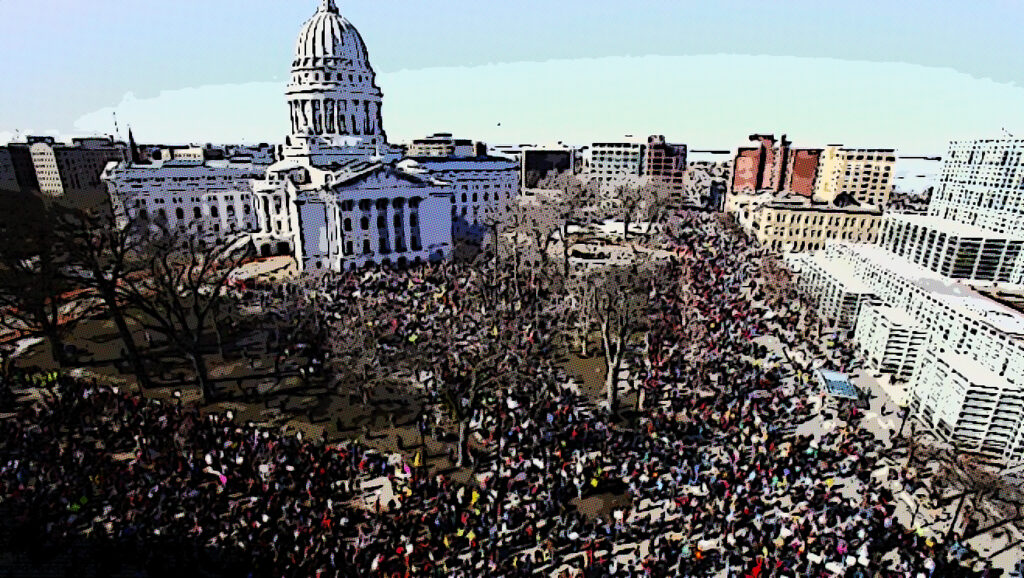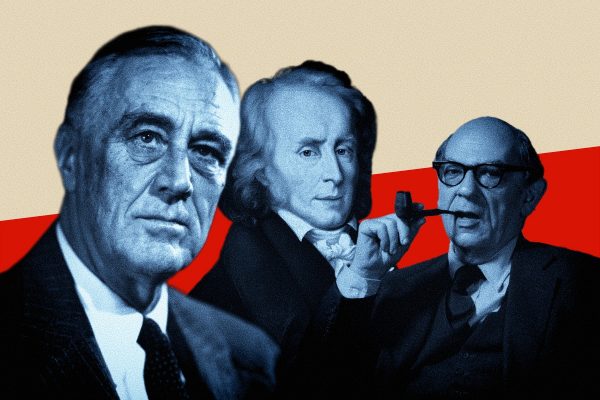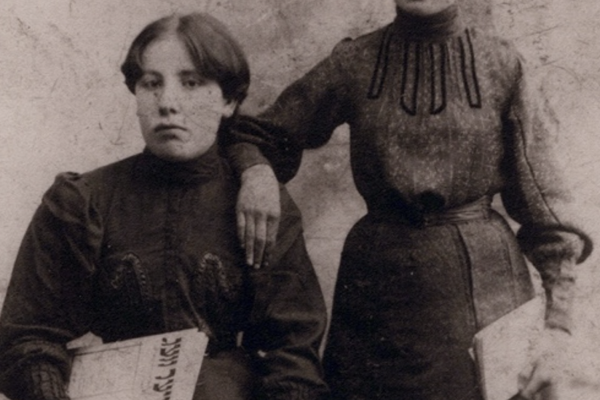As we in the United States organize ourselves individually and collectively to respond to a Trump presidency, we must not forget a very different political rupture of 2016, one that in the long run may turn out to be far more consequential: the widespread revival of social hope led by Bernie Sanders.
For three decades we have watched the shrinking of the social amidst the maelstrom of postindustrial capitalism, increasing cynicism, and the privatization of hope. With the hypertrophy of the individual has come the injunction, as sociologist Ulrich Beck describes it, to find “biographical solutions for systemic contradictions.” Under the reign of freewheeling global capitalism, the perils produced by private corporations in a deregulated and delocalized marketplace became the responsibility of individuals to master—by learning more “skills,” becoming more “entrepreneurial,” or exhibiting greater “responsibility.” (Never mind those problems individuals can’t possibly master, such as climate change.) This paradigm finally reached its breaking point in American politics early this year, when U.S. presidential candidates advocating familiar neoliberal nostrums were either shoved aside entirely (in the case of Republicans) or seriously challenged (in the case of Democrats). The dramatic successes of both the Trump and Sanders campaigns dealt a clear blow to the Washington consensus that individuals must handle social problems on their own and the implicit premise that things could not be radically different. Both campaigns created an explosive sense of possibility where none had been on offer in American electoral politics, rising up against the widespread political resignation borne of a neoliberal vacuum and further entrenched by the return of politics-as-usual after the Great Recession. Each campaign demanded vigorous (if very different types of) government action to solve the crises.
We have witnessed a genuine renewal of social hope in the United States and must work to keep it alive.
This is not to say the two movements are equivalent; of course they diverge in almost every other respect. If Trump’s campaign has restored a kind of hope to members of the white working class, it is not the hope of collective action or forward-looking social progress but its distorting-mirror opposite, a cynical and retrograde faith in the authoritarian strongman: if we can’t change things—more precisely, if we can’t make things the way they were before—maybe he can. Trump supporters came together to get him elected to reverse deindustrialization, not to work together themselves to build a better society. The Sanders campaign, by contrast—transposing the collective energies of Occupy Wall Street to the electoral sphere and extending the moral climate of anti-austerity movements in Spain, Greece, and the United Kingdom—flew in the face of the widespread doubts that collectivities still exist whose action can produce meaningful change.
Though it has now been overshadowed by the stunning victory of bigoted nativism—whether loudly supported or quietly overlooked by most Republicans as well as particular members of the working class—we must not forget that this year we have witnessed the groundwork being laid for a genuine revival of social hope in the United States. I do not mean a renewed faith in grand narratives or a vague and misty-eyed optimism but the tough-minded and inspired disposition to act collectively to make the world more equal, more democratic, more peaceful, more secure, and more just. Despite the defeat of the Sanders campaign, and despite Trump’s victory, we must understand this hope and work to keep it alive.
• • •
Social hope is not merely a personal attitude, a mood, a feeling: that dismissive way of characterizing it makes it difficult to pin down, even embarrassing. (This, along with the disappointing accommodations made by Obama’s administration after campaigning on hope and the affirmation that “Yes We Can,” may explain in part why the idea is so widely ignored and often belittled on the left.) Social hope is, instead, a substantive yoking together of the personal and the public, the emotional and the material: it stands for feelings, yes, but also values, actions, analyses, and expectations. It is potency and possibility and vision, yet always linked to what we do. Underpinning the hard labor of social organizing is an animating force that brings and keeps people together, inspires them to keep going, and creates a sense of fellowship. It is the experience of belonging both to specific movements and to the larger arc of history which, in small ways and large, have made the world freer, more equal, and more just. Social hope is that shared understanding that emerges in organized action and makes it possible, that links itself to other movements and their demands, both past and present. Those of us who have had the experience of social organizing know all the labor that goes into it, but underneath the activity is a wider and deeper spirit that sustains it all.
Sanders revived in electoral politics a vision of collective action and social progress long besieged by neoliberalism.
The Sanders campaign cultivated this kind of vision of collective action—a we committed to expanding and deepening democracy. It created a sense of active community at its events, on the Internet, and on social media. It fueled a belief that things could change and that the movement itself would help to enact that change. It focused on relations of power and privilege and proposed specific changes to a system of inequality and poverty. Maybe these goals were fanciful, but its feeling for possibility was not: it helped raise money from millions of small donors, and it grew like wildfire as Bernie began to win primaries and give Hillary Clinton a run for her money.
Many have wondered what to make of the irony that it took a gruff septuagenarian to revive social hope on the left. After all, Sanders had long been a lone wolf, a socialist without a party. His campaign garnered some support from liberal advocacy groups and local unions, but he drew mainly on the college-educated white millennials and students who filled his rallies—as individuals rather than as representatives of an organization. Clinton, by contrast, had close and old ties to her party organization and an established network of unions and liberal advocacy groups, which in the primaries helped her achieve majority support among women, blacks, Latinos, Asians, and probably unionized white workers—certainly those in the public sector. How, then, did this little known senator with no experience tapping large organizations to build national coalitions—unlike his Democratic opponent—manage the most significant left popular mobilization in American electoral politics since William Jennings Bryan ran for president in 1896?
The answer would seem to lie in the particular kind of hope he gave voice to—especially when juxtaposed against the neoliberal establishment Clinton had come to symbolize, despite her long career working for a wide range of social reforms and the very real hopes of millions of women that the country might elect its first female president. Though the Sanders campaign did not hinge explicitly on a slogan of hope, as Obama’s did, still the stuff of hope—sincerity, idealism, a rejection of cynicism, a sense of possibility—was among its most striking attributes. There was a broad, even universal appeal implicit in Sanders’s policy prescriptions: reducing inequality by insisting that the very rich pay a fair share of their income in taxes; the right of everyone to earn a living wage; the need for government-funded universal health care; the end to corrupt campaign financing; free college education; the undoing of corporate-friendly free trade agreements; and a renewed focus on protecting the environment.
This vision was not of socialism in the sense of worker control of the means of production; beyond breaking up the big banks, rejecting free trade, and enlarging the American welfare state in a Scandinavian direction, it did not look for alternative forms of democratizing the economy. Instead it aimed after a political reversal of the oligarchic character of American society within a broad accommodation to capitalism. Key to this vision was a clear insistence on government intervention on behalf of workers, the environment, citizens, and civil society. The socialism of the Sanders movement was thus, above all, a determination to think and act socially, to tackle problems collectively.
By calling himself a democratic socialist, Sanders broke a great taboo in American politics. Amazingly, he was rewarded for it.
By calling himself a democratic socialist, Sanders broke a great taboo in American politics. Amazingly, he was rewarded rather than punished for it—at least by a large portion of the electorate, if not by superdelegates, other elected officials, and the Democratic Party apparatus. This may help to explain his remarkable success within an electoral system that generally excels at shutting out fringe candidates. His use of the vocabulary of socialism invoked a tradition of social justice even older than his own participation in the civil rights struggles of the 1960s. This raspy-voiced, white-haired old man proudly situated himself within the historical moral arc of struggles for justice, peace, and freedom and brought tens of millions with him. As with Jeremy Corbyn at the head of Britain’s Labour Party, Sanders linked his campaign with a rich and meaningful past, both its achievements and its values.
• • •
What made Trump’s appeal different? Like Sanders, Trump declaimed that something is fundamentally wrong in American society. He too attracted millions of supporters by airing genuine grievances; even many mainstream Republicans who at first ostracized him eventually came around. And like Sanders, he mobilized people furious at party elites and rejected conventional fundraising, though in his case using his own wealth to avoid the problem altogether and brilliantly playing the media for endless free coverage. Rallying many of the activists, organizations, and energies that had made the Tea Party a major force in the Republican Party, Trump defeated a sorry parade of mainstream candidates, drawing large audiences with his entertaining freeform rants against the establishment and his shameless self-promotion.
Trump embodies what might better be called anti-hope, rooted in nostalgia, cynicism, and a feeling of powerlessness. It is not the spirit of generous, inclusive, activist social hope rekindled by Sanders.
The media mostly portrayed Trump as the spokesperson for a deplorable remnant of the white working class—aggrieved white men angry about free trade, hostile to immigrants and minorities but not to capitalism, mobilized against terrorists but not madmen with assault rifles, lacking any vision of action they themselves might take other than cheering the anti-establishment rants of this self-aggrandizing dealmaker. Yet exit polls have revealed that the vast majority of Trump voters thought his most important quality was his ability to “bring needed change.” He thus embodied, for many Americans, a kind of hope. Some observers discovered as much after listening carefully to his supporters’ own words, learning that many were troubled by his instability or his more extreme policy proposals. As Alexander Zaitchik describes it, Trump’s appeal was more essential: he spoke more seriously than his Republican opponents and Hillary Clinton about the loss of manufacturing and mining jobs and fears of terrorism. And Arlie Hochschild has shown that Trump’s message resonated with many who feel that the government—too busy advancing minorities, welcoming immigrants, and sending jobs abroad—is indifferent to the needs of whites. In this context, Trump’s trash talking and anti-establishment persona worked immensely to his favor; he was seen as speaking truth to corrupt elite power and determined to do something for those who had become economically and culturally invisible to other politicians. As Chris Lehmann has pointed out, the hope Trump engendered turned on the “mystic deal-making prowess” that he “exercises by sheer force of charisma”—a kind of magical thinking inspired by his spiritual guide and onetime pastor, Norman Vincent Peale, author of The Power of Positive Thinking. (There can be no doubt that his charisma will only grow after having won the presidency against such great odds.)
If this is hope, it is falsified by Trump’s toxic combination of cynicism and bullshit. It certainly is not the spirit of generous, inclusive, activist social hope rekindled by Sanders. After all, Trump’s public support coalesced around exclusionary fear, racism, authoritarianism, and misogyny. And for all the energy it generated, the Trump campaign never really became a movement; it seems unlikely that it will survive to become a governing coalition. In the words of Brian Beutler, movement leaders “sometimes achieve measures of fame, but much of the work of movement-building is done in the field, and requires strategic acumen, organizing, fundraising, mobilization, recruitment, endurance, and ideological dedication.” Very little of this happened during the Trump campaign, and very little was asked of his followers. This real estate magnate and reality TV star was not anointed by a political party, labor unions, civic groups, or community organizations. His campaign was about what he would do, not what we might do. As he proudly summed up in his RNC acceptance speech, he alone can fix it.
It remains to be seen whether the kind of distorted hope Trump seems to embody for his supporters—what might better be called anti-hope, rooted as it is in nostalgia and a deep-seated feeling of powerlessness—will amount to more than a snow job or empty posturing. Rick Perlstein has argued that the Trump campaign reprised a familiar American tradition: Trump as the snake-oil salesman and his supporters as his marks. (“Believe me,” he exhorted unctuously again and again. His personal testimony undercut impersonal facts and countervailing evidence, substituting for them a sense of irrefutable personal righteousness.) Yet Trump was not the only one acting, or acting out. He appealed to many hungering precisely for brash, obscene posturing. Shaking up the system, giving it the finger, but in fact changing very little: this may be the movement’s legacy considering that the Republican establishment that Trump was supposed to supplant was reelected by wide margins, eager now to implement a familiar agenda over the next four years. Whose hope is this?
• • •
Anti-hope is an old story in Europe and the United States, stretching from Italian fascism and Nazism to Brexit, France’s National Front, Austria’s Freedom Party, and now the election of Donald Trump. Yet if the history of the modern West is blighted by such recurrences of vicious and sometimes murderous authoritarianism, by eruptions of racial, ethnic, cultural, economic, and religious defensiveness, it also cannot be understood apart from the opposed currents of social hope, which mostly belong to the left. From the Enlightenment forward, this vision has been characterized by a shared sense of the good, the we who can bring it about, and the conviction that attaining it is possible. Ernst Bloch argued in his masterwork Das Prinzip Hoffnung (1954)—The Principle of Hope—that only Marxism can realize what humans have hoped for throughout history. As he describes it, Marxism is both softly and deeply subjective, the “warm stream” as in the most personal fantasies, and objective, the “cold stream” projecting concrete possibilities. The two are intimately connected: historically the former was stirred by the growth of the latter in the form of modern science and technology, industrialization, democratic revolutions, and secularization. But for a long time now the cold stream has ceased to point to a better world, and over the past generation the warm stream—whether or not it called itself Marxist—has been accused of illusory utopianism as it labored to preserve or reinvent a vision of collective progress.
This kind of hope, so depleted over the past generation, was revived by Occupy, various movements abroad, and then the Sanders campaign. It remains the burgeoning vital force of the left in the United States today. Though it will be more difficult to do so now that Sanders has lost and Trump has won the presidency, it is urgent that we understand and continue to talk about social hope—and that we work to keep its renewal alive. Trump may have the wind in his sails, but this very fact has galvanized organizing around a common enemy. How things turn out will depend on what we do as we act together.








